Onion garlic or hair onion - what is Rocambole garlic and how to grow it correctly and use it wisely
Bow and garlic - constant ingredients of almost any national cuisine. These aromatic seasonings enhance the taste of food and give it a piquant touch. However, for the same reason, some people refuse garlic: it is unpleasant when your breath has a “spicy note”. The problem can be easily solved if you replace the garlic with garlic onions. It combines the properties of both vegetables, and its taste and aroma are much softer.
Meet: rocambole onion garlic - description, useful properties, features, rules of cultivation and use.
Onions with garlic flavor
Rockambol has several names. It is called onion garlic, hair onion, Egyptian onion, Spanish garlic, garden wild garlic.
Rocambole garlic combines the properties of two vegetables. This applies to both its appearance and taste. Two-year-old heads resemble large garlic and can reach a weight of 300 g. In the first year after planting the cloves, the root crop looks more like an onion and is not divided into cloves.
The flowers of the plant resemble purple balls, exactly the same inflorescences appear on onions. The above-ground part of onion garlic resembles a powerful leek.
Reference! Rocambole was originally a wild plant. Therefore, it can be found not only in gardens and vegetable gardens, but also in meadows and clearings.
Photo of rockambole:
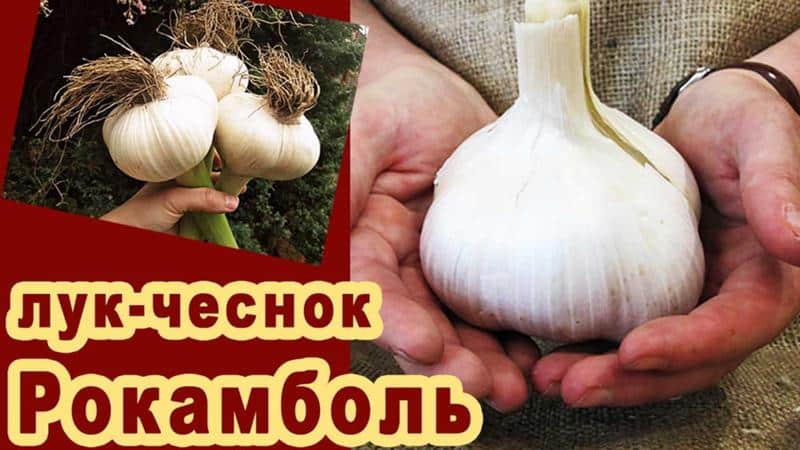
Origin history and interesting facts
It is believed that the birthplace of rocambole is Central Asia.There it has been actively used for several hundred years for preparing fish and meat dishes. In the 18th century, it began to be actively cultivated in Mediterranean countries, the North Caucasus and Europe. The first mention of the hair bow in Russia appeared in 1877. But this vegetable is still considered exotic in our country.
Interesting! The ancient Egyptians attributed magical properties and divine origin to all plants of the onion genus. Rocambole was widely used by this great civilization during its heyday.
Varieties of onion garlic
Rocambole has long been appreciated by agricultural technicians. Russian breeders have also developed new varieties of this crop. Domestic varieties of onion garlic are distinguished by the fact that they can be planted even in the coldest regions.
Rocambole varieties:
- Elephant rockambole. On average, the bulb reaches 200 g. One root vegetable can contain up to 7 cloves.
- Janissary. The weight of the root crop is up to 100 g.
- Pearl. One head of garlic weighs 50 g. The taste is sharper than previous options.
All varieties presented are resistant to frost. They are excellent for growing in the central regions of Russia. Classic rocambola is more heat-loving, but reaches large sizes.
Features of the hair bow
Rocambole has the qualities of both onions and garlic. At the same time, it differs from these cultures.
Features of rockambole:
- big size;
- less pungent taste and less pronounced smell than garlic;
- onion-garlic aroma;
- the ground part looks like leeks, and tastes like garlic.
- reproduces by bulblets formed at the base of the heads.
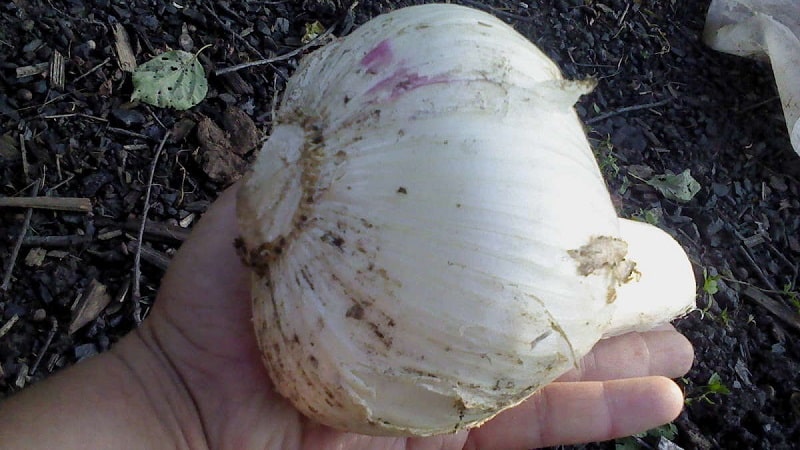
Characteristics of the vegetable
To understand whether rocambole is worth growing, it's worth familiarizing yourself with its impressive characteristics.
Description of Rocambole Garlic:
| Options | Indicators |
| Root vegetable | Large. It can reach 200-300 g in size. In some cases, the heads can grow up to 400 g. There are from 5 to 7 cloves in one head. The taste is garlic-onion, soft. When cut, the flesh is beige in color. |
| Aboveground part | The stem is powerful and thick, reaching a height of 80 cm. The light green leaves are long (up to 60 cm) and wide. They have a garlicky taste and smell. Up to 9 leaves are formed on one plant. Onion garlic throws out arrows 1 m high with small lilac flowers collected in a large ball. |
| Reproduction | The inflorescences do not produce seeds. The culture reproduces by bulbs formed at the base of the head. On average, one rocambole head grows from 10 to 15 bulbs, each of which weighs 2-4 g. The bulbs are covered with a dense shell. |
| Landing dates | Rocambole can be planted in spring or winter. In the first year, the children produce a large onion, not divided into cloves. In the second year, it continues into slices, taking the shape of a head of garlic. |
Root composition
Onion garlic contains proteins, carbohydrates, allicin, germanium, magnesium, manganese, potassium, selenium, calcium, zinc, sodium, sulfides, vitamins A, B, PP, E and C, iron, phytoncides, carotene, essential oils.
The calorie content of 100 g of onion and garlic is 149 kcal. This amount of root vegetable accounts for 6.4 g of protein, 31 g of carbohydrates, 0.5 g of fat.
Hair onion has choleretic, antimicrobial, antiviral, immunomodulatory, vasodilating, blood thinning and anthelmintic effects. By consuming rocambola, you can cleanse your body of toxins and improve digestion.
How to plant Rocambole
Rocambole is an easy crop to grow. Onion garlic can be planted in any region of our country. It easily takes root in open ground and does not require special care.
Soil preparation
To get a high-quality harvest of garlic onions, you need to properly prepare the soil for planting. Rules for preparing the soil for planting rocambole:
- For onion-garlic, a plot of land on which legumes, zucchini, cabbage, radish, rapeseed, cucumbers or rye were previously grown is suitable.
- It is better to plant onion garlic in a well-lit, not darkened place.
- At least two months before planting, it is necessary to dig up the soil and enrich it with humus, ash and manure.
Preparation of planting material
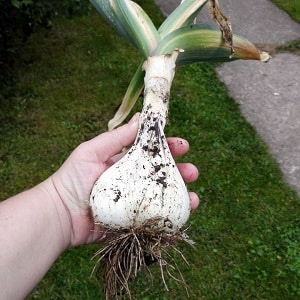 In order for all planting material to germinate, it must be stored correctly. Before planting, it is prepared, preventing infection of the rocambole with plant diseases and accelerating the appearance of the first shoots:
In order for all planting material to germinate, it must be stored correctly. Before planting, it is prepared, preventing infection of the rocambole with plant diseases and accelerating the appearance of the first shoots:
- Daughter bulbs are sorted by size. The larger they are, the larger the onion garlic heads will be.
- Store the bulbs for planting in a dry, dark place at a temperature of 25 degrees.
- The bulbous planting material is freed from the hard shell. This will make it easier for him to germinate. Such measures are not carried out with teeth.
- Before planting, onion garlic is placed in a place with a temperature of 0 degrees. After keeping it there for 21 days, the planting material is taken out into the sun. This will allow the rockambola to quickly adapt to new conditions in the garden.
- Before planting in the ground, the bulbs are treated with a weak solution of potassium permanganate. Planting material should be soaked in it for 12 hours.
Important! Planting and caring for rocambole is similar to cultivating garlic.However, this culture is distinguished by its unpretentiousness and frost resistance.
Planting onion garlic
Onion garlic can be planted at different times of the year. The basic rules for placing planting material in the ground do not depend on this:
- Dig trenches 25 cm wide. Moisten the soil. The distance between rows can vary between 10-20 cm.
- Place the rocambole bulbs at a distance of 20 cm from each other.
- Fill the trenches with soil without compacting it.
The timing of planting determines how quickly the rocambole will produce a harvest. You can plant onion garlic in spring, autumn and winter.
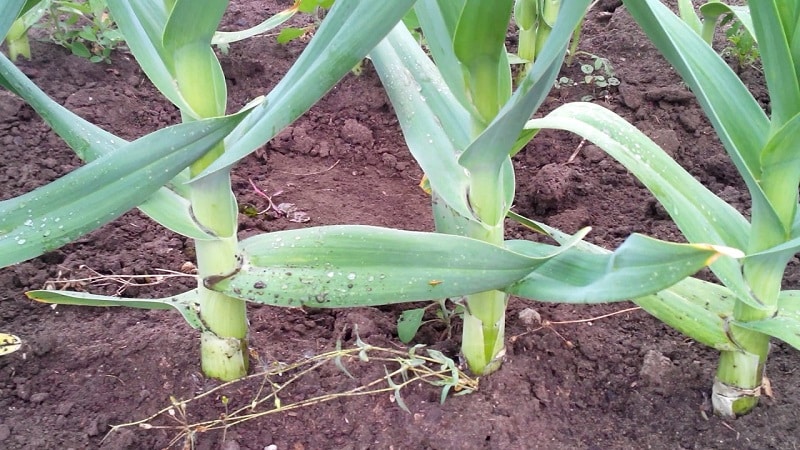
In winter
According to gardeners, it is winter onion garlic produces the largest harvest. Rocambole can be planted in this way in any region of our country.
At least 2 months before work you need to prepare the beds. Garlic is planted 14 days before the first frost. During this time, the planting material will have time to take root, but will not germinate.
The depth of the trench should be 30 cm. Place compost at the bottom of the recess. The thickness of this layer should be within 7 cm.
Mulching when planting garlic in winter is mandatory. This will protect it from freezing. Hay, dry leaves or compost are used as mulch.
For autumn
If you plant onion garlic in the fall, then the next year they will turn into large heads, divided into cloves. In this case, planting material is placed in the soil in September.
When planting in autumn, trenches are dug 10 cm deep. After planting, it is advisable to mulch the onions.
in spring
Work begins as soon as it becomes possible to dig up the soil. Onion garlic is not afraid of frost and germinates at a temperature of 5 degrees.
When planting in spring, the depth of the trenches should be 10 cm. Before planting, it must be well moistened. It is not necessary to mulch the beds.
Cultivation care
Rules for caring for rockambola:
- Watering. Hair onion is a moisture-loving plant. It needs to be watered abundantly and regularly, not allowing the soil to dry out. You need to use settled water for these purposes.
- Loosening. You need to loosen the soil after every watering and rain. This will prevent the formation of an earthen crust that interferes with normal air exchange.
- Feeding. Be sure to feed the garlic twice a season. The first fertilizing with nitrogenous fertilizers is carried out during the period when the first shoots. The second time the crop is fertilized with phosphorus-potassium compounds during the formation of the bulbs.
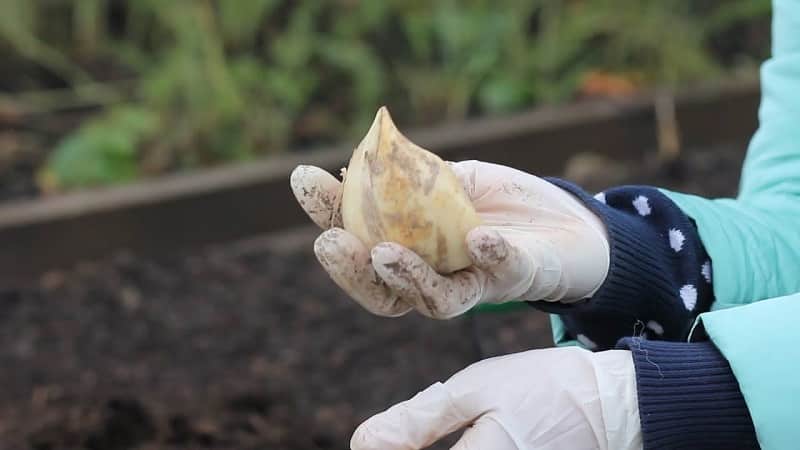
What difficulties might you encounter?
In order for the rockambole to grow healthy and please you with large heads, monitor the condition: any changes are signs that the culture is missing something.
The quality of the onion-garlic harvest largely depends on the composition of the soil. If the greens have become withered and yellowed ahead of time, it is necessary to add additional fertilizing. Use special fertilizers for onions and garlic.
Conditions required for growing hair onions, ideal for weeds. Therefore, weeding beds with rocambola is mandatory.
The arrows with inflorescences that the plant produces are beautiful, but useless. They do not contain viable seeds, but take nutrients from root vegetables. Therefore they need to be removed.
What diseases and pests are hair bows susceptible to?
There are not many diseases and pests in the world that can affect garlic. But you will still have to protect the crop from some of them:
- Fusarium. It is expressed in the form of rotting of the bottom and roots of onion garlic. Caused by a fungus. The reasons for the appearance are considered to be improper care of plants and damage to root crops by insects. Garlic and onions should not be planted in beds affected by this disease for several years.
- Root mite. In most cases, it affects already harvested onion garlic, causing it to dry out. To prevent its occurrence, dry the crop well and promptly remove rotten and damaged heads.
- Onion fly. This pest penetrates the bulb through the bottom and eats it from the inside. To prevent its occurrence, sprinkle the beds with a mixture of tobacco, ash and black pepper once a week.
Harvesting and storage
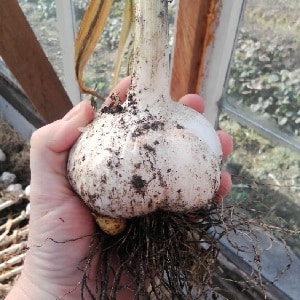 Harvest rocambole when its greens begin to yellow and dry out. You should not delay the moment of digging up the crop, as this can lead to the heads scattering into cloves right in the ground.
Harvest rocambole when its greens begin to yellow and dry out. You should not delay the moment of digging up the crop, as this can lead to the heads scattering into cloves right in the ground.
Untimely removal of onion garlic from the ground will reduce its shelf life.
Dig up the crop carefully so as not to damage it or separate the bulbs suitable for subsequent planting. The soil is removed from the heads by hand so as not to damage them.
After harvesting, the above-ground part should not be separated from the heads. She will increase keeping quality onion garlic. Vegetables are tied into bundles or braided and hung to dry.
Check the onion garlic regularly. Remove damaged and rotten heads from the total mass. It is best to store rocambola in boxes.
Where is onion garlic used?
The uses of rockambola are extensive. It is used in cooking and folk medicine.
Onion garlic is suitable for preparing hot and cold dishes. They can successfully replace both onions and garlic. In Asian cuisine, it is often added to fish and meat dishes.
In Siberia, the taste of pickled and salted rocambole was appreciated. They say that in this form it resembles capers.
In folk medicine, rocambola is used to treat colds and viral diseases, gastritis and hypertension. Eating vegetables every day prevents liver cancer, reduces cholesterol, and improves the condition of skin and hair.
Advantages of the variety
Benefits of rockambol:
- large heads;
- a large number of useful microelements in the composition;
- despite its similarity to garlic, it has a milder taste and aroma;
- easy to care for;
- unpretentious to grow;
- successfully reproduces vegetatively.
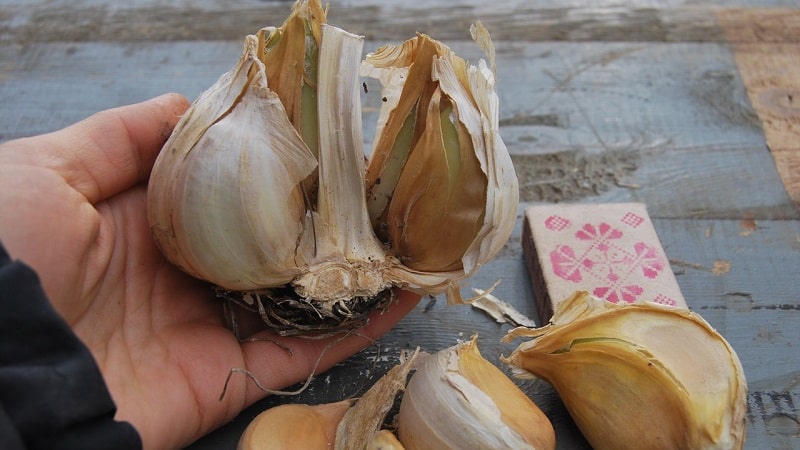
Farmer reviews
In our country, rockambole is still poorly distributed. Moreover, everyone who tried to grow this vegetable was satisfied with the result.
Belova Irina, Samara: “For several years now I have been growing rocambola instead of garlic. There is no more fuss with it, and it tastes better. It is softer and does not leave a characteristic smell in the mouth, but the beneficial properties are the same. I really like that the heads and teeth are huge.”
Chernousov Roma, Kursk: “I really liked the Egyptian onion. Excellent taste and size of heads. I didn’t encounter any difficulties in growing.”
Conclusion
Rocambole is a cross between onion and garlic. Its above-ground part resembles a leek, and its underground part resembles large garlic. The vegetable contains all the most beneficial microelements from both crops.
Onion garlic is of wild origin and therefore does not require special care. A novice gardener can easily cope with growing this exotic vegetable.